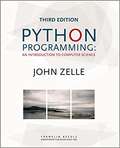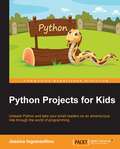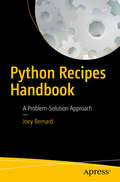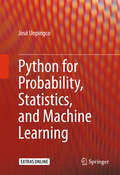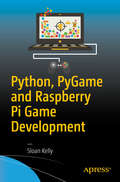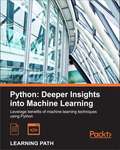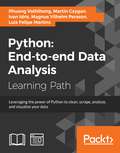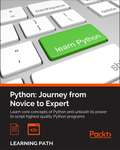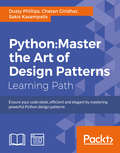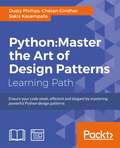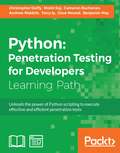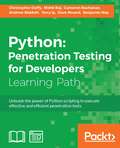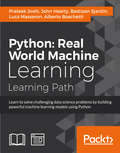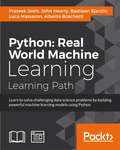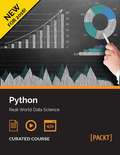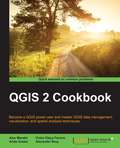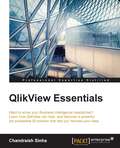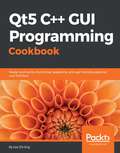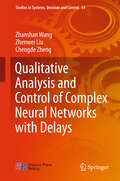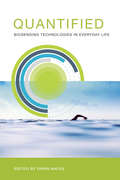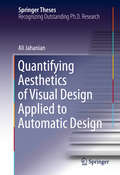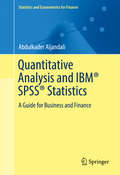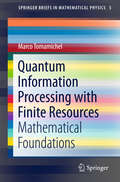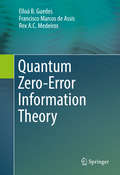- Table View
- List View
Python Programming: An Introduction To Computer Science
by John M. ZelleThis third edition of John Zelle's Python Programming continues the tradition of updating the text to reflect new technologies while maintaining a time-tested approach to teaching introductory computer science. An important change to this edition is the removal of most uses of eval and the addition of a discussion of its dangers. In our increasingly connected world, it's never too early to begin considering computer security issues.
Python Projects for Kids
by Jessica IngrassellinoUnleash Python and take your small readers on an adventurous ride through the world of programming About This Book * Learn to start using Python for some simple programming tasks such as doing easy mathematical calculations. * Use logic and control loops to build a nice interesting game. * Get to grips with working with data and, once you're comfortable with that, you'll be introduced to Pygame, which will help you wrap up the book with a cool game. Who This Book Is For This book is for kids (aged 10 and over). This is book is intended for absolute beginners who lack any knowledge of computing or programming languages and want to get started in the world of programming. What You Will Learn * Start fiddling with Python's variables, build functions and interact with users * Build your own calculator using the Math Library * Train Python to make logical decisions * Work with moving 2D objects on-screen * Understand the Pygame Library and build your very own game! * Write a cool program to manage inventories in your backpack In Detail Kids are always the most fast-paced and enthusiastic learners, and are naturally willing to build stuff that looks like magic at the end (when it works!). Programming can be one such magic. Being able to write a program that works helps them feel they've really achieved something. Kids today are very tech-savvy and cannot wait to enter the fast-paced digital world. Because Python is one of the most popular languages and has a syntax that is quite simple to understand, even kids are eager to use it as a stepping stone to learning programming languages. This book will cover projects that are simple and fun, and teach kids how to write Python code that works. The book will teach the basics of Python programming, installation, and so on and then will move on to projects. A total of three projects, with each and every step explained carefully, without any assumption of previous experience. Style and approach The book will take a light approach in guiding the little readers through the world of Python. The main idea is to teach by example and let the readers have as much exercises to do, so that they learn faster and can apply their own ideas to the existing examples. The book should get them thinking, by the end, on where they can go next with such a powerful tool at their disposal.
Python Recipes Handbook
by Joey BernardLearn the code to write algorithms, numerical computations, data analysis and much more using the Python language: look up and re-use the recipes for your own Python coding. This book is your handy code cookbook reference. Whether you're a maker, game developer, cloud computing programmer and more, this is a must-have reference for your library. Python Recipes Handbook gives you the most common and contemporary code snippets, using pandas (Python Data Analysis Library), NumPy, and other numerical Python packages. What You'll LearnCode with the pandas (Python Data Analysis Library)Work with the various Python algorithms useful for today's big data analytics and cloud applicationsUse NumPy and other numerical Python packages and code for doing various kinds of analysisDiscover Python's new popular modules, packages, extensions and templates libraryWho This Book Is ForThis handy reference is for those with some experience with Python.
Python for Probability, Statistics, and Machine Learning
by José UnpingcoThis book covers thekey ideas that link probability, statistics, and machine learning illustratedusing Python modules in these areas. The entire text, including all thefigures and numerical results, is reproducible using the Python codes and theirassociated Jupyter/IPython notebooks, which are provided as supplementarydownloads. The author develops key intuitions in machine learning by workingmeaningful examples using multiple analytical methods and Python codes, therebyconnecting theoretical concepts to concrete implementations. Modern Pythonmodules like Pandas, Sympy, and Scikit-learn are applied to simulate andvisualize important machine learning concepts like the bias/variance trade-off,cross-validation, and regularization. Many abstract mathematical ideas, such asconvergence in probability theory, are developed and illustrated with numericalexamples. This book is suitable for anyone with an undergraduate-levelexposure to probability, statistics, or machine learning and with rudimentaryknowledge of Python programming.
Python for Probability, Statistics, and Machine Learning
by José UnpingcoThis book, fully updated for Python version 3.6+, covers the key ideas that link probability, statistics, and machine learning illustrated using Python modules in these areas. All the figures and numerical results are reproducible using the Python codes provided. The author develops key intuitions in machine learning by working meaningful examples using multiple analytical methods and Python codes, thereby connecting theoretical concepts to concrete implementations. Detailed proofs for certain important results are also provided. Modern Python modules like Pandas, Sympy, Scikit-learn, Tensorflow, and Keras are applied to simulate and visualize important machine learning concepts like the bias/variance trade-off, cross-validation, and regularization. Many abstract mathematical ideas, such as convergence in probability theory, are developed and illustrated with numerical examples. This updated edition now includes the Fisher Exact Test and the Mann-Whitney-Wilcoxon Test. A new section on survival analysis has been included as well as substantial development of Generalized Linear Models. The new deep learning section for image processing includes an in-depth discussion of gradient descent methods that underpin all deep learning algorithms. As with the prior edition, there are new and updated *Programming Tips* that the illustrate effective Python modules and methods for scientific programming and machine learning. There are 445 run-able code blocks with corresponding outputs that have been tested for accuracy. Over 158 graphical visualizations (almost all generated using Python) illustrate the concepts that are developed both in code and in mathematics. We also discuss and use key Python modules such as Numpy, Scikit-learn, Sympy, Scipy, Lifelines, CvxPy, Theano, Matplotlib, Pandas, Tensorflow, Statsmodels, and Keras.This book is suitable for anyone with an undergraduate-level exposure to probability, statistics, or machine learning and with rudimentary knowledge of Python programming.
Python, PyGame and Raspberry Pi Game Development
by Sloan KellyGain the basics of Python and use PyGame to create fast-paced video games with great graphics and sounds. You'll also learn about object oriented programming (OOP) as well as design patterns like model-view-controller (MVC) and finite state machines (FSMs). Python, PyGame and Raspberry Pi Game Development teaches you how to use Python and PyGame on your computer. Whether you use Windows, macOS, Linux, or a Raspberry Pi you can unleash the power of Python and PyGame to create great looking games. Included in the text are complete code listings and explanations for "Bricks," "Snake" and "Invaders"-- three fully-working games. These allow you to get started making your own great games. Modify them or build your own exciting titles. What You'll Learn Gain the basics of Python and employ it for game development Design your game Build games using game projects as templates like Bricks, Snake, and Invaders Work with user defined functions, inheritance, composition, and aggregation Add sound to your games Implement finite state machines Who This Book Is For Experienced coders or game developers new to Python, PyGame and Raspberry Pi. This book is also for makers interested in getting into game development.
Python: Deeper Insights into Machine Learning
by Sebastian Raschka David Julian John HeartyLeverage benefits of machine learning techniques using Python About This Book * Improve and optimise machine learning systems using effective strategies. * Develop a strategy to deal with a large amount of data. * Use of Python code for implementing a range of machine learning algorithms and techniques. Who This Book Is For This title is for data scientist and researchers who are already into the field of data science and want to see machine learning in action and explore its real-world application. Prior knowledge of Python programming and mathematics is must with basic knowledge of machine learning concepts. What You Will Learn * Learn to write clean and elegant Python code that will optimize the strength of your algorithms * Uncover hidden patterns and structures in data with clustering * Improve accuracy and consistency of results using powerful feature engineering techniques * Gain practical and theoretical understanding of cutting-edge deep learning algorithms * Solve unique tasks by building models * Get grips on the machine learning design process In Detail Machine learning and predictive analytics are becoming one of the key strategies for unlocking growth in a challenging contemporary marketplace. It is one of the fastest growing trends in modern computing, and everyone wants to get into the field of machine learning. In order to obtain sufficient recognition in this field, one must be able to understand and design a machine learning system that serves the needs of a project. The idea is to prepare a learning path that will help you to tackle the real-world complexities of modern machine learning with innovative and cutting-edge techniques. Also, it will give you a solid foundation in the machine learning design process, and enable you to build customized machine learning models to solve unique problems. The course begins with getting your Python fundamentals nailed down. It focuses on answering the right questions that cove a wide range of powerful Python libraries, including scikit-learn Theano and Keras.After getting familiar with Python core concepts, it's time to dive into the field of data science. You will further gain a solid foundation on the machine learning design and also learn to customize models for solving problems. At a later stage, you will get a grip on more advanced techniques and acquire a broad set of powerful skills in the area of feature selection and feature engineering. Style and approach This course includes all the resources that will help you jump into the data science field with Python. The aim is to walk through the elements of Python covering powerful machine learning libraries. This course will explain important machine learning models in a step-by-step manner. Each topic is well explained with real-world applications with detailed guidance.Through this comprehensive guide, you will be able to explore machine learning techniques.
Python: End-to-end Data Analysis
by Ivan Idris Phuong Vothihong Martin Czygan Luiz Felipe Martins Magnus Vilhelm PerssonLeverage the power of Python to clean, scrape, analyze, and visualize your data About This Book • Clean, format, and explore your data using the popular Python libraries and get valuable insights from it • Analyze big data sets; create attractive visualizations; manipulate and process various data types using NumPy, SciPy, and matplotlib; and more • Packed with easy-to-follow examples to develop advanced computational skills for the analysis of complex data Who This Book Is For This course is for developers, analysts, and data scientists who want to learn data analysis from scratch. This course will provide you with a solid foundation from which to analyze data with varying complexity. A working knowledge of Python (and a strong interest in playing with your data) is recommended. What You Will Learn • Understand the importance of data analysis and master its processing steps • Get comfortable using Python and its associated data analysis libraries such as Pandas, NumPy, and SciPy • Clean and transform your data and apply advanced statistical analysis to create attractive visualizations • Analyze images and time series data • Mine text and analyze social networks • Perform web scraping and work with different databases, Hadoop, and Spark • Use statistical models to discover patterns in data • Detect similarities and differences in data with clustering • Work with Jupyter Notebook to produce publication-ready figures to be included in reports In Detail Data analysis is the process of applying logical and analytical reasoning to study each component of data present in the system. Python is a multi-domain, high-level, programming language that offers a range of tools and libraries suitable for all purposes, it has slowly evolved as one of the primary languages for data science. Have you ever imagined becoming an expert at effectively approaching data analysis problems, solving them, and extracting all of the available information from your data? If yes, look no further, this is the course you need! In this course, we will get you started with Python data analysis by introducing the basics of data analysis and supported Python libraries such as matplotlib, NumPy, and pandas. Create visualizations by choosing color maps, different shapes, sizes, and palettes then delve into statistical data analysis using distribution algorithms and correlations. You'll then find your way around different data and numerical problems, get to grips with Spark and HDFS, and set up migration scripts for web mining. You'll be able to quickly and accurately perform hands-on sorting, reduction, and subsequent analysis, and fully appreciate how data analysis methods can support business decision-making. Finally, you will delve into advanced techniques such as performing regression, quantifying cause and effect using Bayesian methods, and discovering how to use Python's tools for supervised machine learning. The course provides you with highly practical content explaining data analysis with Python, from the following Packt books: 1. Getting Started with Python Data Analysis. 2. Python Data Analysis Cookbook. 3. Mastering Python Data Analysis. By the end of this course, you will have all the knowledge you need to analyze your data with varying complexity levels, and turn it into actionable insights. Style and approach Learn Python data analysis using engaging examples and fun exercises, and with a gentle and friendly but comprehensive "learn-by-doing" approach. It offers you a useful way of analyzing the data that's specific to this course, but that can also be applied to any other data. This course is designed to be both a guide and a reference for moving beyond the basics of data analysis.
Python: Journey from Novice to Expert
by Dusty Phillips Fabrizio Romano Rick Van HattemLearn core concepts of Python and unleash its power to script highest quality Python programs About This Book * Develop a strong set of programming skills with Pyhton that you will be able to express in any situation, on every platform, thanks to Python's portability * Stop writing scripts and start architecting programs by applying object-oriented programming techniques in Python * Learn the trickier aspects of Python and put it in a structured context for deeper understanding of the language Who This Book Is For This course is meant for programmers who wants to learn Python programming from a basic to an expert level. The course is mostly self-contained and introduces Python programming to a new reader and can help him become an expert in this trade. What You Will Learn * Get Python up and running on Windows, Mac, and Linux in no time * Grasp the fundamental concepts of coding, along with the basics of data structures and control flow * Understand when to use the functional or the object-oriented programming approach * Extend class functionality using inheritance * Exploit object-oriented programming in key Python technologies, such as Kivy and Django * Understand how and when to use the functional programming paradigm * Use the multiprocessing library, not just locally but also across multiple machines In Detail Python is a dynamic and powerful programming language, having its application in a wide range of domains. It has an easy-to-use, simple syntax, and a powerful library, which includes hundreds of modules to provide routines for a wide range of applications, thus making it a popular language among programing enthusiasts.This course will take you on a journey from basic programming practices to high-end tools and techniques giving you an edge over your peers. It follows an interesting learning path, divided into three modules. As you complete each one, you'll have gained key skills and get ready for the material in the next module.The first module will begin with exploring all the essentials of Python programming in an easy-to-understand way. This will lay a good foundation for those who are interested in digging deeper. It has a practical and example-oriented approach through which both the introductory and the advanced topics are explained. Starting with the fundamentals of programming and Python, it ends by exploring topics, like GUIs, web apps, and data science.In the second module you will learn about object oriented programming techniques in Python. Starting with a detailed analysis of object-oriented technique and design, you will use the Python programming language to clearly grasp key concepts from the object-oriented paradigm. This module fully explains classes, data encapsulation, inheritance, polymorphism, abstraction, and exceptions with an emphasis on when you can use each principle to develop well-designed software.With a good foundation of Python you will move onto the third module which is a comprehensive tutorial covering advanced features of the Python language. Start by creating a project-specific environment using venv. This will introduce you to various Pythonic syntax and common pitfalls before moving onto functional features and advanced concepts, thereby gaining an expert level knowledge in programming and teaching how to script highest quality Python programs. Style and approach This course follows a theory-cum-practical approach having all the ingredients that will help you jump into the field of Python programming as a novice and grow-up as an expert. The aim is to create a smooth learning path that will teach you how to get started with Python and carry out expert-level programming techniques at the end of course.
Python: Master the Art of Design Patterns
by Dusty Phillips Sakis Kasampalis Chetan GiridharEnsure your code is sleek, efficient and elegant by mastering powerful Python design patterns About This Book * Learn all about abstract design patterns and how to implement them in Python 3 * Understand the structural, creational, and behavioral Python design patterns * Get to know the context and application of design patterns to solve real-world problems in software architecture, design, and application development * Discover how to simplify Design Pattern implementation using the power of Python 3 Who This Book Is For If you have basic Python skills and wish to learn in depth how to correctly apply appropriate design patterns, this course is tailor made for you. What You Will Learn * Discover what design patterns are and how to apply them to writing Python * Implement objects in Python by creating classes and defining methods * Separate related objects into a taxonomy of classes and describe the properties and behaviors of those objects via the class interface * Understand when to use object-oriented features, and more importantly when not to use them * Get to know proven solutions to common design issues * Explore the design principles that form the basis of software design, such as loose coupling, the Hollywood principle, and the Open Close principle, among others * Use Structural Design Patterns and find out how objects and classes interact to build larger applications * Improve the productivity and code base of your application using Python design patterns * Secure an interface using the Proxy pattern In Detail Python is an object-oriented scripting language that is used in everything from data science to web development. Known for its simplicity, Python increases productivity and minimizes development time. Through applying essential software engineering design patterns to Python, Python code becomes even more efficient and reusable from project to project. This learning path takes you through every traditional and advanced design pattern best applied to Python code, building your skills in writing exceptional Python. Divided into three distinct modules, you'll go from foundational to advanced concepts by following a series of practical tutorials. Start with the bedrock of Python programming - the object-oriented paradigm. Rethink the way you work with Python as you work through the Python data structures and object-oriented techniques essential to modern Python programming. Build your confidence as you learn Python syntax, and how to use OOP principles with Python tools such as Django and Kivy. In the second module, run through the most common and most useful design patterns from a Python perspective. Progress through Singleton patterns, Factory patterns, Facade patterns and more all with detailed hands-on guidance. Enhance your professional abilities in in software architecture, design, and development. In the final module, run through the more complex and less common design patterns, discovering how to apply them to Python coding with the help of real-world examples. Get to grips with the best practices of writing Python, as well as creating systems architecture and troubleshooting issues. This Learning Path combines some of the best that Packt has to offer in one complete, curated package. It includes content from the following Packt products: * Python 3 Object-Oriented Programming - Second Edition by Dusty Phillips * Learning Python Design Patterns - Second Edition by Chetan Giridhar * Mastering Python Design Patterns by Sakis Kasampalis Style and approach Advance your Python code through three distinct modules that each build on preceding content. Get the complete coverage of Python design patterns you need to write elegant and efficient code that's reusable and powerful.
Python: Master the Art of Design Patterns
by Dusty Phillips Sakis Kasampalis Chetan GiridharEnsure your code is sleek, efficient and elegant by mastering powerful Python design patterns About This Book Learn all about abstract design patterns and how to implement them in Python 3 Understand the structural, creational, and behavioral Python design patterns Get to know the context and application of design patterns to solve real-world problems in software architecture, design, and application development Discover how to simplify Design Pattern implementation using the power of Python 3 Who This Book Is For If you have basic Python skills and wish to learn in depth how to correctly apply appropriate design patterns, this course is tailor made for you. What You Will Learn Discover what design patterns are and how to apply them to writing Python Implement objects in Python by creating classes and defining methods Separate related objects into a taxonomy of classes and describe the properties and behaviors of those objects via the class interface Understand when to use object-oriented features, and more importantly when not to use them Get to know proven solutions to common design issues Explore the design principles that form the basis of software design, such as loose coupling, the Hollywood principle, and the Open Close principle, among others Use Structural Design Patterns and find out how objects and classes interact to build larger applications Improve the productivity and code base of your application using Python design patterns Secure an interface using the Proxy pattern In Detail Python is an object-oriented scripting language that is used in everything from data science to web development. Known for its simplicity, Python increases productivity and minimizes development time. Through applying essential software engineering design patterns to Python, Python code becomes even more efficient and reusable from project to project. This learning path takes you through every traditional and advanced design pattern best applied to Python code, building your skills in writing exceptional Python. Divided into three distinct modules, you'll go from foundational to advanced concepts by following a series of practical tutorials. Start with the bedrock of Python programming – the object-oriented paradigm. Rethink the way you work with Python as you work through the Python data structures and object-oriented techniques essential to modern Python programming. Build your confidence as you learn Python syntax, and how to use OOP principles with Python tools such as Django and Kivy. In the second module, run through the most common and most useful design patterns from a Python perspective. Progress through Singleton patterns, Factory patterns, Facade patterns and more all with detailed hands-on guidance. Enhance your professional abilities in in software architecture, design, and development. In the final module, run through the more complex and less common design patterns, discovering how to apply them to Python coding with the help of real-world examples. Get to grips with the best practices of writing Python, as well as creating systems architecture and troubleshooting issues. This Learning Path combines some of the best that Packt has to offer in one complete, curated package. It includes content from the following Packt products: Python 3 Object-Oriented Programming - Second Edition by Dusty Phillips Learning Python Design Patterns - Second Edition by Chetan Giridhar Mastering Python Design Patterns by Sakis Kasampalis Style and approach Advance your Python code through three distinct modules that each build on preceding content. Get the complete coverage of Python design patterns you need to write elegant and efficient code that's reusable and powerful.
Python: Penetration Testing for Developers
by Cameron Buchanan Mohit Terry Ip Christopher Duffy Andrew Mabbitt Dave Mound Benjamin MayUnleash the power of Python scripting to execute effective and efficient penetration tests About This Book * Sharpen your pentesting skills with Python * Develop your fluency with Python to write sharper scripts for rigorous security testing * Get stuck into some of the most powerful tools in the security world Who This Book Is For If you are a Python programmer or a security researcher who has basic knowledge of Python programming and wants to learn about penetration testing with the help of Python, this course is ideal for you. Even if you are new to the field of ethical hacking, this course can help you find the vulnerabilities in your system so that you are ready to tackle any kind of attack or intrusion. What You Will Learn * Familiarize yourself with the generation of Metasploit resource files and use the Metasploit Remote Procedure Call to automate exploit generation and execution * Exploit the Remote File Inclusion to gain administrative access to systems with Python and other scripting languages * Crack an organization's Internet perimeter and chain exploits to gain deeper access to an organization's resources * Explore wireless traffic with the help of various programs and perform wireless attacks with Python programs * Gather passive information from a website using automated scripts and perform XSS, SQL injection, and parameter tampering attacks * Develop complicated header-based attacks through Python In Detail Cybercriminals are always one step ahead, when it comes to tools and techniques. This means you need to use the same tools and adopt the same mindset to properly secure your software. This course shows you how to do just that, demonstrating how effective Python can be for powerful pentesting that keeps your software safe. Comprising of three key modules, follow each one to push your Python and security skills to the next level. In the first module, we'll show you how to get to grips with the fundamentals. This means you'll quickly find out how to tackle some of the common challenges facing pentesters using custom Python tools designed specifically for your needs. You'll also learn what tools to use and when, giving you complete confidence when deploying your pentester tools to combat any potential threat. In the next module you'll begin hacking into the application layer. Covering everything from parameter tampering, DDoS, XXS and SQL injection, it will build on the knowledge and skills you learned in the first module to make you an even more fluent security expert. Finally in the third module, you'll find more than 60 Python pentesting recipes. We think this will soon become your trusted resource for any pentesting situation. This Learning Path combines some of the best that Packt has to offer in one complete, curated package. It includes content from the following Packt products: * Learning Penetration Testing with Python by Christopher Duffy * Python Penetration Testing Essentials by Mohit * Python Web Penetration Testing Cookbook by Cameron Buchanan,Terry Ip, Andrew Mabbitt, Benjamin May and Dave Mound Style and approach This course provides a quick access to powerful, modern tools, and customizable scripts to kick-start the creation of your own Python web penetration testing toolbox.
Python: Penetration Testing for Developers
by Cameron Buchanan Mohit Terry Ip Christopher Duffy Andrew Mabbitt Dave Mound Benjamin MayUnleash the power of Python scripting to execute effective and efficient penetration tests About This Book Sharpen your pentesting skills with Python Develop your fluency with Python to write sharper scripts for rigorous security testing Get stuck into some of the most powerful tools in the security world Who This Book Is For If you are a Python programmer or a security researcher who has basic knowledge of Python programming and wants to learn about penetration testing with the help of Python, this course is ideal for you. Even if you are new to the field of ethical hacking, this course can help you find the vulnerabilities in your system so that you are ready to tackle any kind of attack or intrusion. What You Will Learn Familiarize yourself with the generation of Metasploit resource files and use the Metasploit Remote Procedure Call to automate exploit generation and execution Exploit the Remote File Inclusion to gain administrative access to systems with Python and other scripting languages Crack an organization's Internet perimeter and chain exploits to gain deeper access to an organization's resources Explore wireless traffic with the help of various programs and perform wireless attacks with Python programs Gather passive information from a website using automated scripts and perform XSS, SQL injection, and parameter tampering attacks Develop complicated header-based attacks through Python In Detail Cybercriminals are always one step ahead, when it comes to tools and techniques. This means you need to use the same tools and adopt the same mindset to properly secure your software. This course shows you how to do just that, demonstrating how effective Python can be for powerful pentesting that keeps your software safe. Comprising of three key modules, follow each one to push your Python and security skills to the next level. In the first module, we'll show you how to get to grips with the fundamentals. This means you'll quickly find out how to tackle some of the common challenges facing pentesters using custom Python tools designed specifically for your needs. You'll also learn what tools to use and when, giving you complete confidence when deploying your pentester tools to combat any potential threat. In the next module you'll begin hacking into the application layer. Covering everything from parameter tampering, DDoS, XXS and SQL injection, it will build on the knowledge and skills you learned in the first module to make you an even more fluent security expert. Finally in the third module, you'll find more than 60 Python pentesting recipes. We think this will soon become your trusted resource for any pentesting situation. This Learning Path combines some of the best that Packt has to offer in one complete, curated package. It includes content from the following Packt products: Learning Penetration Testing with Python by Christopher Duffy Python Penetration Testing Essentials by Mohit Python Web Penetration Testing Cookbook by Cameron Buchanan,Terry Ip, Andrew Mabbitt, Benjamin May and Dave Mound Style and approach This course provides a quick access to powerful, modern tools, and customizable scripts to kick-start the creation of your own Python web penetration testing toolbox.
Python: Real World Machine Learning
by Alberto Boschetti Luca Massaron Prateek Joshi John Hearty Bastiaan SjardinLearn to solve challenging data science problems by building powerful machine learning models using Python About This Book * Understand which algorithms to use in a given context with the help of this exciting recipe-based guide * This practical tutorial tackles real-world computing problems through a rigorous and effective approach * Build state-of-the-art models and develop personalized recommendations to perform machine learning at scale Who This Book Is For This Learning Path is for Python programmers who are looking to use machine learning algorithms to create real-world applications. It is ideal for Python professionals who want to work with large and complex datasets and Python developers and analysts or data scientists who are looking to add to their existing skills by accessing some of the most powerful recent trends in data science. Experience with Python, Jupyter Notebooks, and command-line execution together with a good level of mathematical knowledge to understand the concepts is expected. Machine learning basic knowledge is also expected. What You Will Learn * Use predictive modeling and apply it to real-world problems * Understand how to perform market segmentation using unsupervised learning * Apply your new-found skills to solve real problems, through clearly-explained code for every technique and test * Compete with top data scientists by gaining a practical and theoretical understanding of cutting-edge deep learning algorithms * Increase predictive accuracy with deep learning and scalable data-handling techniques * Work with modern state-of-the-art large-scale machine learning techniques * Learn to use Python code to implement a range of machine learning algorithms and techniques In Detail Machine learning is increasingly spreading in the modern data-driven world. It is used extensively across many fields such as search engines, robotics, self-driving cars, and more. Machine learning is transforming the way we understand and interact with the world around us. In the first module, Python Machine Learning Cookbook, you will learn how to perform various machine learning tasks using a wide variety of machine learning algorithms to solve real-world problems and use Python to implement these algorithms. The second module, Advanced Machine Learning with Python, is designed to take you on a guided tour of the most relevant and powerful machine learning techniques and you'll acquire a broad set of powerful skills in the area of feature selection and feature engineering. The third module in this learning path, Large Scale Machine Learning with Python, dives into scalable machine learning and the three forms of scalability. It covers the most effective machine learning techniques on a map reduce framework in Hadoop and Spark in Python. This Learning Path will teach you Python machine learning for the real world. The machine learning techniques covered in this Learning Path are at the forefront of commercial practice. This Learning Path combines some of the best that Packt has to offer in one complete, curated package. It includes content from the following Packt products: * Python Machine Learning Cookbook by Prateek Joshi * Advanced Machine Learning with Python by John Hearty * Large Scale Machine Learning with Python by Bastiaan Sjardin, Alberto Boschetti, Luca Massaron Style and approach This course is a smooth learning path that will teach you how to get started with Python machine learning for the real world, and develop solutions to real-world problems. Through this comprehensive course, you'll learn to create the most effective machine learning techniques from scratch and more!
Python: Real World Machine Learning
by Prateek JoshiLearn to solve challenging data science problems by building powerful machine learning models using Python About This Book Understand which algorithms to use in a given context with the help of this exciting recipe-based guide This practical tutorial tackles real-world computing problems through a rigorous and effective approach Build state-of-the-art models and develop personalized recommendations to perform machine learning at scale Who This Book Is For This Learning Path is for Python programmers who are looking to use machine learning algorithms to create real-world applications. It is ideal for Python professionals who want to work with large and complex datasets and Python developers and analysts or data scientists who are looking to add to their existing skills by accessing some of the most powerful recent trends in data science. Experience with Python, Jupyter Notebooks, and command-line execution together with a good level of mathematical knowledge to understand the concepts is expected. Machine learning basic knowledge is also expected. What You Will Learn Use predictive modeling and apply it to real-world problems Understand how to perform market segmentation using unsupervised learning Apply your new-found skills to solve real problems, through clearly-explained code for every technique and test Compete with top data scientists by gaining a practical and theoretical understanding of cutting-edge deep learning algorithms Increase predictive accuracy with deep learning and scalable data-handling techniques Work with modern state-of-the-art large-scale machine learning techniques Learn to use Python code to implement a range of machine learning algorithms and techniques In Detail Machine learning is increasingly spreading in the modern data-driven world. It is used extensively across many fields such as search engines, robotics, self-driving cars, and more. Machine learning is transforming the way we understand and interact with the world around us. In the first module, Python Machine Learning Cookbook, you will learn how to perform various machine learning tasks using a wide variety of machine learning algorithms to solve real-world problems and use Python to implement these algorithms. The second module, Advanced Machine Learning with Python, is designed to take you on a guided tour of the most relevant and powerful machine learning techniques and you'll acquire a broad set of powerful skills in the area of feature selection and feature engineering. The third module in this learning path, Large Scale Machine Learning with Python, dives into scalable machine learning and the three forms of scalability. It covers the most effective machine learning techniques on a map reduce framework in Hadoop and Spark in Python. This Learning Path will teach you Python machine learning for the real world. The machine learning techniques covered in this Learning Path are at the forefront of commercial practice. This Learning Path combines some of the best that Packt has to offer in one complete, curated package. It includes content from the following Packt products: Python Machine Learning Cookbook by Prateek Joshi Advanced Machine Learning with Python by John Hearty Large Scale Machine Learning with Python by Bastiaan Sjardin, Alberto Boschetti, Luca Massaron Style and approach This course is a smooth learning path that will teach you how to get started with Python machine learning for the real world, and develop solutions to real-world problems. Through this comprehensive course, you'll learn to create the most effective machine learning techniques from scratch and more!
Python: Real-World Data Science
by Sebastian Raschka Dusty Phillips Robert Layton Fabrizio Romano Martin Czygan Phuong Vo.T.HUnleash the power of Python and its robust data science capabilities About This Book • Unleash the power of Python 3 objects • Learn to use powerful Python libraries for effective data processing and analysis • Harness the power of Python to analyze data and create insightful predictive models • Unlock deeper insights into machine learning with this vital guide to cutting-edge predictive analytics Who This Book Is For Entry-level analysts who want to enter in the data science world will find this course very useful to get themselves acquainted with Python's data science capabilities for doing real-world data analysis. What You Will Learn • Install and setup Python • Implement objects in Python by creating classes and defining methods • Get acquainted with NumPy to use it with arrays and array-oriented computing in data analysis • Create effective visualizations for presenting your data using Matplotlib • Process and analyze data using the time series capabilities of pandas • Interact with different kind of database systems, such as file, disk format, Mongo, and Redis • Apply data mining concepts to real-world problems • Compute on big data, including real-time data from the Internet • Explore how to use different machine learning models to ask different questions of your data In Detail The Python: Real-World Data Science course will take you on a journey to become an efficient data science practitioner by thoroughly understanding the key concepts of Python. This learning path is divided into four modules and each module are a mini course in their own right, and as you complete each one, you'll have gained key skills and be ready for the material in the next module. The course begins with getting your Python fundamentals nailed down. After getting familiar with Python core concepts, it's time that you dive into the field of data science. In the second module, you'll learn how to perform data analysis using Python in a practical and example-driven way. The third module will teach you how to design and develop data mining applications using a variety of datasets, starting with basic classification and affinity analysis to more complex data types including text, images, and graphs. Machine learning and predictive analytics have become the most important approaches to uncover data gold mines. In the final module, we'll discuss the necessary details regarding machine learning concepts, offering intuitive yet informative explanations on how machine learning algorithms work, how to use them, and most importantly, how to avoid the common pitfalls. Style and approach This course includes all the resources that will help you jump into the data science field with Python and learn how to make sense of data. The aim is to create a smooth learning path that will teach you how to get started with powerful Python libraries and perform various data science techniques in depth.
QGIS 2 Cookbook
by Anita Graser Alexander Bruy Alex Mandel Victor Olaya FerreroBecome a QGIS power user and master QGIS data management, visualization, and spatial analysis techniques About This Book * Explore and create time-based visualizations and build interactive maps * Maximize your use of the QGIS features, plugins and toolbox automation * Packed with lots of sample datasets to enable a better understanding of the code Who This Book Is For If you are an intermediate GIS user, with either previous experience in QGIS or any other GIS application, this is the book for you. The recipes can be used to learn more advanced techniques in QGIS or to replicate the functionalities equivalent to other GIS platforms. This book assumes that you already have a working QGIS system in place. What You Will Learn * Import and export common tricky spatial data formats * Perform classic vector and raster analysis with QGIS * Utilize spatial databases and data management tools * Use and create geographic web services and maps * Explore and create time-based visualizations * Perform network building and routing analysis * Extend QGIS capabilities with popular plugins and toolbox automation * Make beautiful and unique maps with customized cartography In Detail QGIS is a user-friendly, cross-platform desktop geographic information system used to make maps and analyze spatial data. QGIS allows users to understand, question, interpret, and visualize spatial data in many ways that reveal relationships, patterns, and trends in the form of maps. This book is a collection of simple to advanced techniques that are needed in everyday geospatial work, and shows how to accomplish them with QGIS. You will begin by understanding the different types of data management techniques, as well as how data exploration works. You will then learn how to perform classic vector and raster analysis with QGIS, apart from creating time-based visualizations. Finally, you will learn how to create interactive and visually appealing maps with custom cartography. By the end of this book, you will have all the necessary knowledge to handle spatial data management, exploration, and visualization tasks in QGIS. Style and approach This book covers practical examples, with step-by-step instructions on how to use real world data covering common GIS operations and the different analysis techniques. It provides detailed explanations and applications of QGIS concepts that will allow the user to effectively analyze spatial data.
QlikView Essentials
by Chandraish SinhaWant to solve your Business Intelligence headaches? Learn how QlikView can help, and discover a powerful yet accessible BI solution that lets you harness your data About This Book * Design interactive dashboards using QlikView to share sharp BI insights * Discover how to create effective data models to manage and harness your data with QlikView's ETL functionality * Learn and implement best practices to successfully integrate QlikView within your organization Who This Book Is For If you recognize the challenges of harnessing data for a modern business this book is for. Maybe you already know a little about QlikView - if you want to learn more, QlikView Essentials is a great way to develop your knowledge and skills. What You Will Learn * Learn the complete QlikView workflow - from loading data, to visualization and analytics * Learn how to Load data from different sources, including QVD files and how to optimize data models for accuracy and precision * Discover solutions to common data modeling problems, so you can respond quickly to changing situations * Create accessible dashboards and quality data visualizations to share insights effectively * Learn how to deploy your BI application for optimal availability In Detail This guide demonstrates just how easy it is to get started with QlikView and create your own BI application. Featuring an introduction to its core features before exploring how to load data and model it, you'll soon become more confident that you can take full advantage of QlikView's capabilities. You will also learn how to use QVD files with QlikView - and how they offer a simpler way of handling data. After digging deeper into data handling, as you learn how to use mapping tables and create a master calendar, you'll then find out how to get the most from QlikView's visualization features - vital if you are to use your data insights effectively. From accessible and user friendly dashboards to strategies and best practices for subjecting data to further analysis, you can be confident that you'll be prepared to get the most out of your data with QlikView. With details on how to finally secure your application and deploy it for a successful integration in your organization, QlikView Essentials underlines exactly why QlikView is becoming more and more popular for businesses that understand the value of data. Style and approach The book takes a step-by-step approach to QlikView development, and is explained in an easy-to-follow style. Each topic is accompanied by an exercise so you can put your knowledge into practice. This book will be useful for you no matter what your needs and experience levels with the technology.
Qt5 C++ GUI Programming Cookbook
by Lee Zhi EngUse Qt5 to design and build a graphical user interface that is functional, appealing, and user-friendly for your software application About This Book * Learn to make use of Qt5 to design and customize the look-and-feel of your application * Improve the visual quality of your application by utilizing the graphic rendering system and animation system provided by Qt5 * A good balance of visual presentation and its contents will make an application appealing yet functional Who This Book Is For This book intended for those who want to develop software using Qt5. If you want to improve the visual quality and content presentation of your software application, this book is best suited to you. What You Will Learn * Customize the look and feel of your application using the widget editor provided by Qt5 * Change the states of the GUI elements to make them appear in a different form * Animating the GUI elements using the built-in animation system provided by Qt5 * Draw shapes and 2D images in your application using Qt5's powerful rendering system * Draw 3D graphics in your application by implementing OpenGL, an industry-standard graphical library to your project * Build a mobile app that supports touch events and export it to your device * Parse and extract data from an XML file, then present it on your software's GUI * Display web content on your program and interact with it by calling JavaScript functions from C++, or calling C++ functions from the web content * Access to MySQL and SQLite databases to retrieve data and display it on your software's GUI In Detail With the advancement of computer technology, the software market is exploding with tons of software choices for the user, making their expectations higher in terms of functionality and the look and feel of the application. Therefore, improving the visual quality of your application is vital in order to overcome the market competition and stand out from the crowd. This book will teach you how to develop functional and appealing software using Qt5 through multiple projects that are interesting and fun. This book covers a variety of topics such as look-and-feel customization, GUI animation, graphics rendering, implementing Google Maps, and more. You will learn tons of useful information, and enjoy the process of working on the creative projects provided in this book. Style and approach This book focuses on customizing the look and feel and utilizing the graphical features provided by Qt5. It takes a step-by-step approach, providing tons of screenshots and sample code for you to follow and learn. Each topic is explained sequentially and placed in context.
Qualitative Analysis and Control of Complex Neural Networks with Delays
by Zhanshan Wang Zhenwei Liu Chengde ZhengThis book focuses on the stability of the dynamical neural system, synchronization of the coupling neural system and their applications in automation control and electrical engineering. The redefined concept of stability, synchronization and consensus are adopted to provide a better explanation of the complex neural network. Researchers in the fields of dynamical systems, computer science, electrical engineering and mathematics will benefit from the discussions on complex systems. The book will also help readers to better understand the theory behind the control technique and its design.
Quantified: Biosensing Technologies in Everyday Life
by Dawn NafusWhat is at stake socially, culturally, politically, and economically when we routinely use technology to gather information about our bodies and environments? Today anyone can purchase technology that can track, quantify, and measure the body and its environment. Wearable or portable sensors detect heart rates, glucose levels, steps taken, water quality, genomes, and microbiomes, and turn them into electronic data. Is this phenomenon empowering, or a new form of social control? Who volunteers to enumerate bodily experiences, and who is forced to do so? Who interprets the resulting data? How does all this affect the relationship between medical practice and self care, between scientific and lay knowledge? Quantified examines these and other issues that arise when biosensing technologies become part of everyday life.The book offers a range of perspectives, with views from the social sciences, cultural studies, journalism, industry, and the nonprofit world. The contributors consider data, personhood, and the urge to self-quantify; legal, commercial, and medical issues, including privacy, the outsourcing of medical advice, and self-tracking as a “paraclinical” practice; and technical concerns, including interoperability, sociotechnical calibration, alternative views of data, and new space for design.ContributorsMarc Böhlen, Geoffrey C. Bowker, Sophie Day, Anna de Paula Hanika, Deborah Estrin, Brittany Fiore-Gartland, Dana Greenfield, Judith Gregory, Mette Kragh-Furbo, Celia Lury, Adrian Mackenzie, Rajiv Mehta, Maggie Mort, Dawn Nafus, Gina Neff, Helen Nissenbaum, Heather Patterson, Celia Roberts, Jamie Sherman, Alex Taylor, Gary Wolf
Quantifying Aesthetics of Visual Design Applied to Automatic Design
by Ali JahanianIn this thesis, the author makes several contributions to thestudy of design of graphical materials. The thesis begins with a review of therelationship between design and aesthetics, and the use of mathematical modelsto capture this relationship. Then, a novel method for linking linguistic concepts to colorsusing the Latent Dirichlet Allocation Dual Topic Model is proposed. Next, the thesis studies the relationship between aesthetics and spatial layout by formalizing the notion of visual balance. Applying principles of salience and Gaussian mixture models over a body of about 120,000 aesthetically rated professional photographs, the author provides confirmation of Arnhem's theory about spatial layout. The thesis concludes with a description oftools to support automatically generating personalized design.
Quantitative Analysis and IBM® SPSS® Statistics
by Abdulkader AljandaliThis guide for practicing statisticians and data scientists who use IBM SPSS for statistical analysis of big data in business and finance is the first of a two-part guide to SPSS for Windows, introducing data entry into SPSS, along with elementary statistical and graphical methods for summarizing and presenting data. Part I also covers the rudiments of hypothesis testing and business forecasting while Part II will present multivariate statistical methods, more advanced forecasting methods, and multivariate methods. IBM SPSS offers a powerful set of statistical and information analysis systems that run on a wide variety of personal computers. The Windows version of SPSS is built around routines that have been developed, tested, and widely used for more than 20 years. As such, SPSS is extensively used in industry, commerce, banking, local and national governments, and education. Just a small subset of users of the package include the major clearing banks, the BBC, British Gas, British Airways, British Telecom, the Consumer Association, Eurotunnel, Glaxo, ICI, London Underground, the NHS, Plessey, Shell, Unilever, and W. H. Smith and Son. Although the emphasis in this guide is on applications of SPSS for Windows, there is a need for users to be aware of the statistical assumptions and rationales underpinning correct and meaningful application of the techniques available in the packa≥ therefore, such assumptions are discussed, and methods of assessing their validity are described. Also presented is the logic underlying the computation of the more commonly used test statistics in the area of hypothesis testing. Mathematical background is kept to a minimum.
Quantum Information Processing with Finite Resources
by Marco TomamichelThis book provides the reader with the mathematical framework required to fully explore the potential of small quantum information processing devices. As decoherence will continue to limit their size, it is essential to master the conceptual tools which make such investigations possible. A strong emphasis is given to information measures that are essential for the study of devices of finite size, including Rényi entropies and smooth entropies. The presentation is self-contained and includes rigorous and concise proofs of the most important properties of these measures. The first chapters will introduce the formalism of quantum mechanics, with particular emphasis on norms and metrics for quantum states. This is necessary to explore quantum generalizations of Rényi divergence and conditional entropy, information measures that lie at the core of information theory. The smooth entropy framework is discussed next and provides a natural means to lift many arguments from information theory to the quantum setting. Finally selected applications of the theory to statistics and cryptography are discussed. The book is aimed at graduate students in Physics and Information Theory. Mathematical fluency is necessary, but no prior knowledge of quantum theory is required.
Quantum Zero-Error Information Theory
by Elloá B. Guedes Francisco Marcos de Assis Rex A. C. MedeirosThis book aims at presenting the field of Quantum Information Theory in an intuitive, didactic and self-contained way, taking into account several multidisciplinary aspects. Therefore, this books is particularly suited to students and researchers willing to grasp fundamental concepts in Quantum Computation and Quantum Information areas. The field of Quantum Information Theory has increased significantly over the last three decades. Many results from classical information theory were translated and extended to a scenario where quantum effects become important. Most of the results in this area allows for an asymptotically small probability of error to represent and transmit information efficiently. Claude E. Shannon was the first scientist to realize that error-free classical information transmission can be accomplished under certain conditions. More recently, the concept of error-free classical communication was translated to the quantum context. The so-called Quantum Zero-Error Information Theory completes and extends the Shannon Zero-Error Information Theory.
